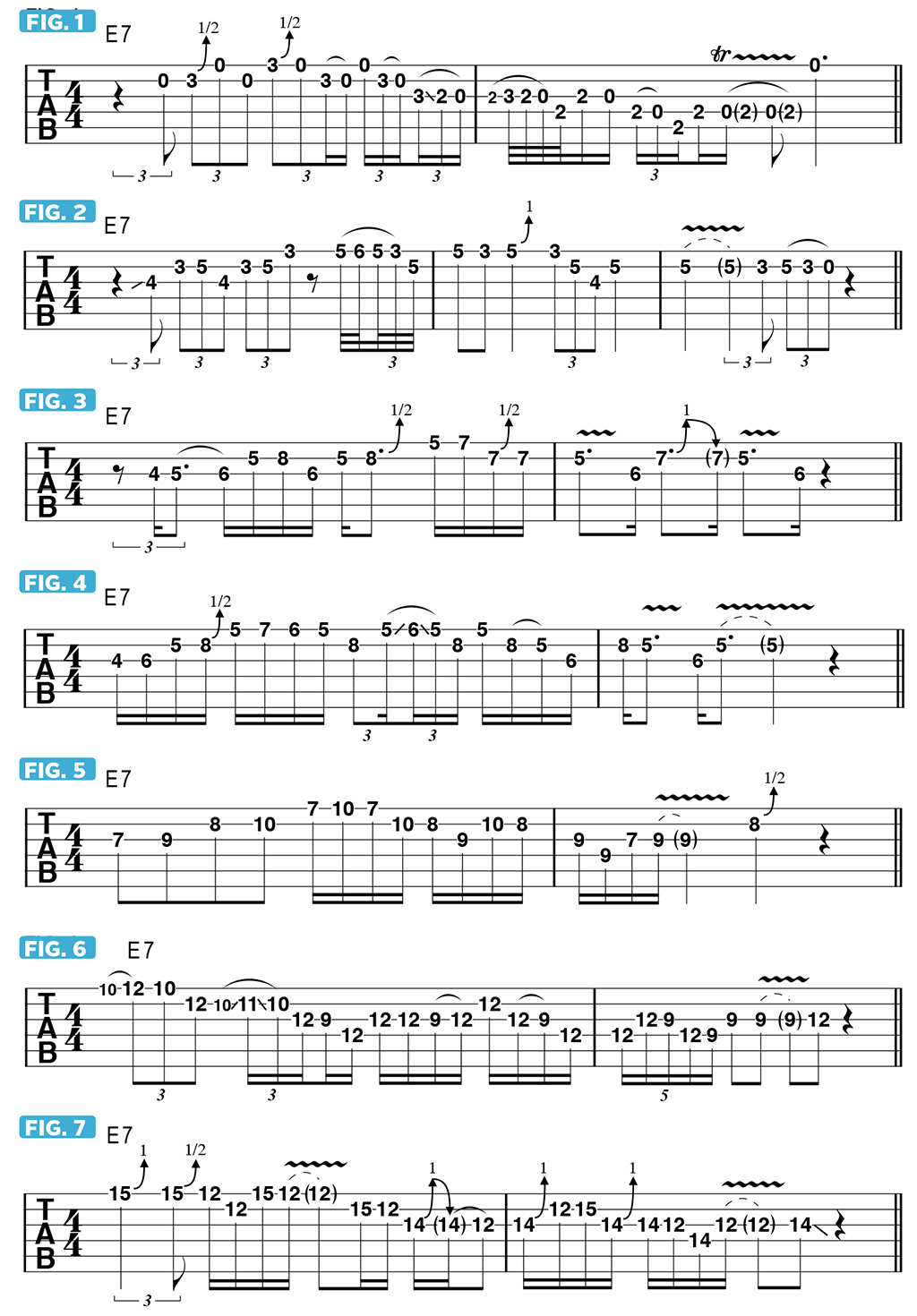Building solos on specific adjacent string groups
Force yourself out of the same old, familiar position-based patterns and into new, uncharted territory
In trying to break out of the standard box positions when playing a solo, an approach I’ve found to be very helpful is to intentionally restrict myself to playing on pairs or groups of adjacent strings. Doing this forces me out of the same old, familiar position-based patterns and into new, uncharted territory while helping me to invent fresh-sounding licks and phrases.
To demonstrate, let’s focus on the top three strings, exploring the key of E and utilizing the E minor pentatonic scale (E G A B D), the E blues scale (E G A Bb B D) and the “B.B. box,” which is a specific fretboard shape that incorporates the major sixth - C# in the key of E - into minor pentatonic and blues-scale licks. Using these parameters, we will move through six areas of the fretboard in devising solo-type melodic lines.
FIGURE 1 is played in “open” position, as it makes abundant use of the open strings. The phrase has an element of rhythmic freedom, in that various rhythms are used. This type of phrasing can be heard in the playing of the great Lightnin’ Hopkins, as well as Jimi Hendrix, Eric Clapton, Johnny Winter and Stevie Ray Vaughan.

In FIGURE 2, I employ this same approach in third position. Again, there’s an element of rhythmic freedom in the improvised line. An effective practice technique would be to experiment with moving back and forth between this and the previous shape and position, with attention to the available note choices, as well as the way in which the lines “fall” on the fretboard.
In FIGURE 3 we move up to the fifth-position “B.B. box” pattern, beginning on C#, on the G string’s sixth fret, followed by E, G, A, Bb and B on the top two strings. Notice the addition of the second, or ninth, F# (B string, seventh fret), which is used for bends up to G and G#. FIGURE 4 offers another phrase played in this same box pattern.
FIGURE 5 brings us to seventh position for E minor pentatonic, a shape many players are well familiar with. Practice moving back and forth between this position and the “B.B. box” located three frets below.
In FIGURE 6, we move up to ninth-10th position. When playing through this cascading phrase, notice the advantages of this fretboard shape and the way in which blues-type lines fall on the strings. Lastly, we move up to 12th position, which is similar to open position, only 12 frets and one octave higher.
Now that you have these shapes under your fingers, try soloing through a 12-bar blues in E while shifting from one position to the next. You’ll find that the possibilities for melodic invention are virtually endless.
Get The Pick Newsletter
All the latest guitar news, interviews, lessons, reviews, deals and more, direct to your inbox!
Guitar World Associate Editor Andy Aledort is recognized worldwide for his vast contributions to guitar instruction, via his many best-selling instructional DVDs, transcription books and online lessons. Andy is a regular contributor to Guitar World and Truefire, and has toured with Dickey Betts of the Allman Brothers, as well as participating in several Jimi Hendrix Tribute Tours.
“There are so many sounds to be discovered when you get away from using a pick”: Jared James Nichols shows you how to add “snap, crackle and pop” to your playing with banjo rolls and string snaps
Don't let chord inversions bamboozle you. It's simply the case of shuffling the notes around








![Joe Bonamassa [left] wears a deep blue suit and polka-dotted shirt and plays his green refin Strat; the late Irish blues legend Rory Gallagher [right] screams and inflicts some punishment on his heavily worn number one Stratocaster.](https://cdn.mos.cms.futurecdn.net/cw28h7UBcTVfTLs7p7eiLe.jpg)


![A black-and-white action shot of Sergeant Thunderhoof perform live: [from left] Mark Sayer, Dan Flitcroft, Jim Camp and Josh Gallop](https://cdn.mos.cms.futurecdn.net/am3UhJbsxAE239XRRZ8zC8.jpg)